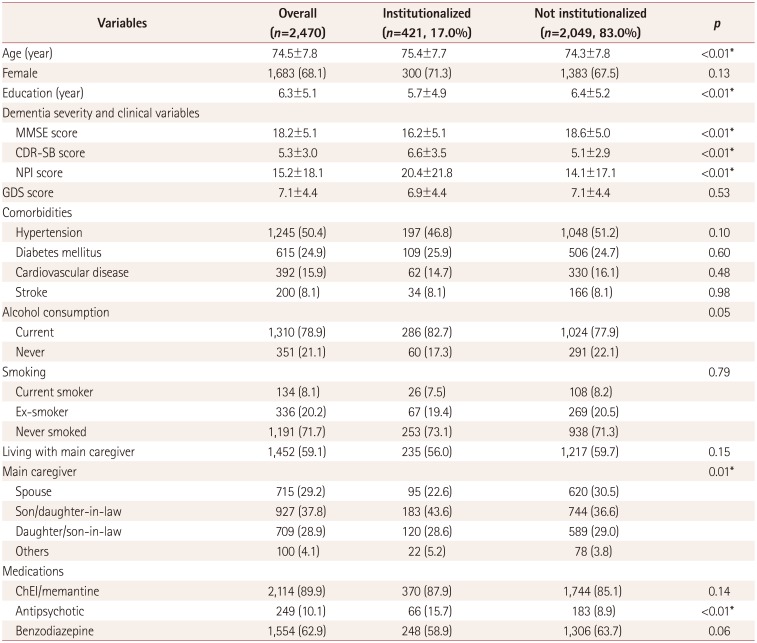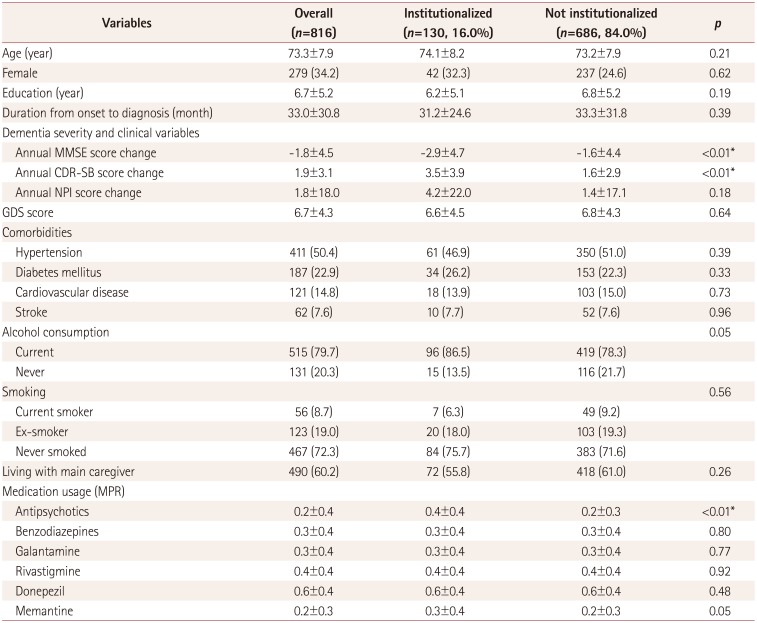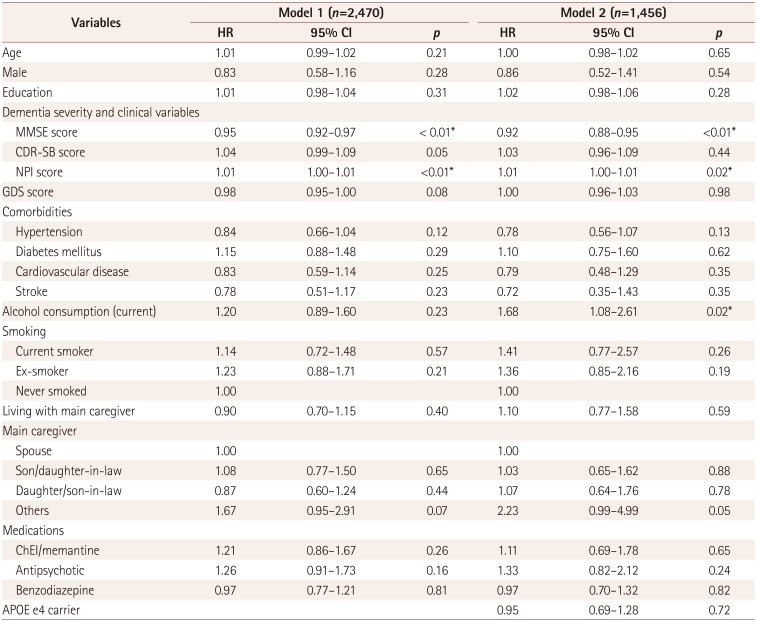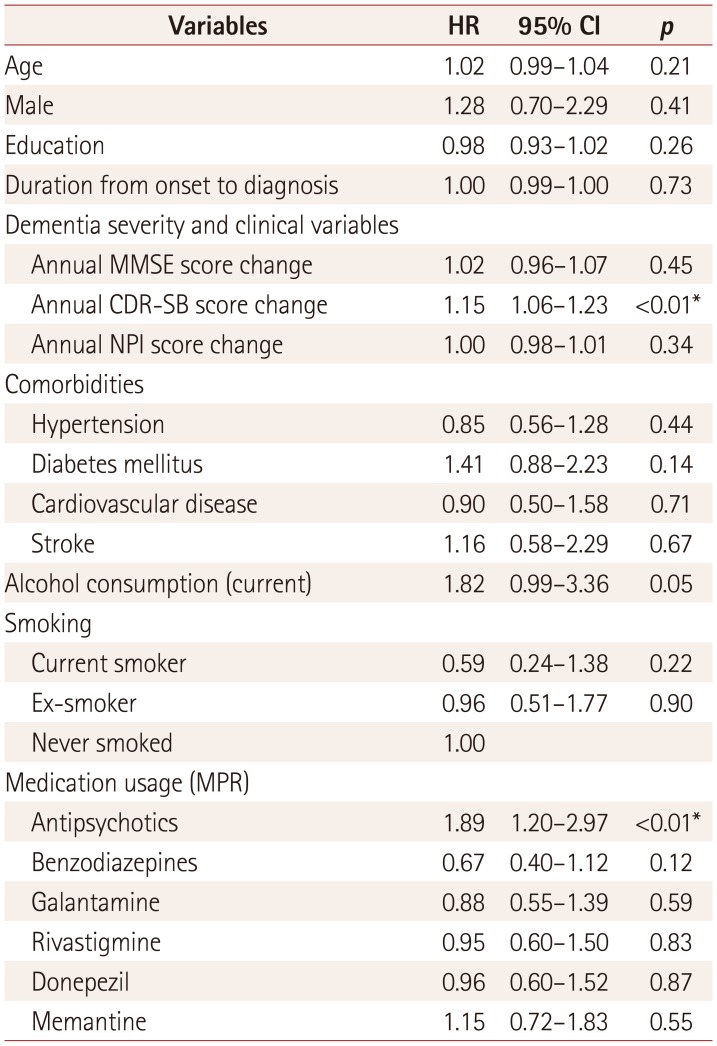1. Agüero-Torres H, von Strauss E, Viitanen M, Winblad B, Fratiglioni L. Institutionalization in the elderly: the role of chronic diseases and dementia. Cross-sectional and longitudinal data from a population-based study. J Clin Epidemiol. 2001; 54:795–801. PMID:
11470388.

2. Agüero-Torres H, Fratiglioni L, Guo Z, Viitanen M, von Strauss E, Winblad B. Dementia is the major cause of functional dependence in the elderly: 3-year follow-up data from a population-based study. Am J Public Health. 1998; 88:1452–1456. PMID:
9772843.

3. Luppa M, Luck T, Brähler E, König HH, Riedel-Heller SG. Prediction of institutionalisation in dementia. A systematic review. Dement Geriatr Cogn Disord. 2008; 26:65–78. PMID:
18617737.
4. Caldwell L, Low LF, Brodaty H. Caregivers' experience of the decision-making process for placing a person with dementia into a nursing home: comparing caregivers from Chinese ethnic minority with those from English-speaking backgrounds. Int Psychogeriatr. 2014; 26:413–424. PMID:
24267583.

5. Gaugler JE, Duval S, Anderson KA, Kane RL. Predicting nursing home admission in the U.S: a meta-analysis. BMC Geriatr. 2007; 7:13. PMID:
17578574.

6. Gaugler JE, Yu F, Krichbaum K, Wyman JF. Predictors of nursing home admission for persons with dementia. Med Care. 2009; 47:191–198. PMID:
19169120.

7. Kim JM, Shin IS, Jeong SJ, Gormley N, Yoon JS. Predictors of institutionalization in patients with dementia in Korea. Int J Geriatr Psychiatry. 2002; 17:101–106. PMID:
11813270.

8. Luppa M, Luck T, Weyerer S, König HH, Brähler E, Riedel-Heller SG. Prediction of institutionalization in the elderly. A systematic review. Age Ageing. 2010; 39:31–38. PMID:
19934075.

9. Wattmo C, Wallin AK, Londos E, Minthon L. Risk factors for nursing home placement in Alzheimer’s disease: a longitudinal study of cognition, ADL, service utilization, and cholinesterase inhibitor treatment. Gerontologist. 2011; 51:17–27. PMID:
20562471.

10. Hébert R, Dubois MF, Wolfson C, Chambers L, Cohen C. Factors associated with long-term institutionalization of older people with dementia: data from the Canadian Study of Health and Aging. J Gerontol A Biol Sci Med Sci. 2001; 56:M693–M699. PMID:
11682577.
11. Gaugler JE, Kane RL, Kane RA, Clay T, Newcomer R. Caregiving and institutionalization of cognitively impaired older people: utilizing dynamic predictors of change. Gerontologist. 2003; 43:219–229. PMID:
12677079.

12. Yaffe K, Fox P, Newcomer R, Sands L, Lindquist K, Dane K, et al. Patient and caregiver characteristics and nursing home placement in patients with dementia. JAMA. 2002; 287:2090–2097. PMID:
11966383.

13. Park HK, Na DL, Han SH, Kim JY, Cheong HK, Kim SY, et al. Clinical characteristics of a nationwide hospital-based registry of mild-to-moderate Alzheimer’s disease patients in Korea: a CREDOS (Clinical Research Center for Dementia of South Korea) study. J Korean Med Sci. 2011; 26:1219–1226. PMID:
21935279.

14. Lee M, Lim TS, Lee HY, Moon SY. Profile of memory impairment as a prognostic marker in amnestic mild cognitive impairment. J Neurol Sci. 2014; 347:124–128. PMID:
25394906.

15. Moon SY, Na DL, Seo SW, Lee JY, Ku BD, Kim SY, et al. Impact of white matter changes on activities of daily living in mild to moderate dementia. Eur Neurol. 2011; 65:223–230. PMID:
21447954.

16. McKhann G, Drachman D, Folstein M, Katzman R, Price D, Stadlan EM. Clinical diagnosis of Alzheimer's disease: report of the NINCDS-ADRDA Work Group under the auspices of Department of Health and Human Services Task Force on Alzheimer's Disease. Neurology. 1984; 34:939–944. PMID:
6610841.

17. Seok JE. Public long-term care insurance for the elderly in Korea: design, characteristics, and tasks. Soc Work Public Health. 2010; 25:185–209. PMID:
20391261.

18. Park IS, Kim SK. Korean elderly long-term care insurance system and long-term care hospital. J Korean Geriatr Soc. 2008; 12:68–73.
19. Kang IO, Park CY, Lee Y. Role of healthcare in Korean long-term care insurance. J Korean Med Sci. 2012; 27(Suppl):S41–S46. PMID:
22661870.

20. Kwon S. The introduction of long-term care insurance in South Korea. Eurohealth. 2009; 15:28–29.
21. Youn G, Knight BG, Jeong HS, Benton D. Differences in familism values and caregiving outcomes among Korean, Korean American, and White American dementia caregivers. Psychol Aging. 1999; 14:355–364. PMID:
10509692.

22. Kim MD, Hong SC, Lee CI, Kim SY, Kang IO, Lee SY. Caregiver burden among caregivers of Koreans with dementia. Gerontology. 2009; 55:106–113. PMID:
19023194.

23. Farrer LA, Cupples LA, Haines JL, Hyman B, Kukull WA, Mayeux R, et al. Effects of age, sex, and ethnicity on the association between apolipoprotein E genotype and Alzheimer disease. A meta-analysis. APOE and Alzheimer Disease Meta Analysis Consortium. JAMA. 1997; 278:1349–1356. PMID:
9343467.

24. Craft S, Teri L, Edland SD, Kukull WA, Schellenberg G, McCormick WC, et al. Accelerated decline in apolipoprotein E-epsilon4 homozygotes with Alzheimer's disease. Neurology. 1998; 51:149–153. PMID:
9674794.
25. Dal Forno G, Rasmusson DX, Brandt J, Carson KA, Brookmeyer R, Troncoso J, et al. Apolipoprotein E genotype and rate of decline in probable Alzheimer's disease. Arch Neurol. 1996; 53:345–350. PMID:
8929157.
26. Kanai M, Shizuka M, Urakami K, Matsubara E, Harigaya Y, Okamoto K, et al. Apolipoprotein E4 accelerates dementia and increases cerebrospinal fluid tau levels in Alzheimer's disease. Neurosci Lett. 1999; 267:65–68. PMID:
10400250.

27. Growdon JH, Locascio JJ, Corkin S, Gomez-Isla T, Hyman BT. Apolipoprotein E genotype does not influence rates of cognitive decline in Alzheimer's disease. Neurology. 1996; 47:444–448. PMID:
8757018.

28. Slooter AJ, Houwing-Duistermaat JJ, van Harskamp F, Cruts M, Van Broeckhoven C, Breteler MM, et al. Apolipoprotein E genotype and progression of Alzheimer's disease: the Rotterdam Study. J Neurol. 1999; 246:304–308. PMID:
10367700.

29. Basun H, Grut M, Winblad B, Lannfelt L. Apolipoprotein epsilon 4 allele and disease progression in patients with late-onset Alzheimer's disease. Neurosci Lett. 1995; 183:32–34. PMID:
7746480.
30. Jonker C, Schmand B, Lindeboom J, Havekes LM, Launer LJ. Association between apolipoprotein E epsilon4 and the rate of cognitive decline in community-dwelling elderly individuals with and without dementia. Arch Neurol. 1998; 55:1065–1069. PMID:
9708956.
31. Stern Y, Brandt J, Albert M, Jacobs DM, Liu X, Bell K, et al. The absence of an apolipoprotein epsilon4 allele is associated with a more aggressive form of Alzheimer’s disease. Ann Neurol. 1997; 41:615–620. PMID:
9153523.
32. Rosen HJ, Narvaez JM, Hallam B, Kramer JH, Wyss-Coray C, Gearhart R, et al. Neuropsychological and functional measures of severity in Alzheimer disease, frontotemporal dementia, and semantic dementia. Alzheimer Dis Assoc Disord. 2004; 18:202–207. PMID:
15592131.








 PDF
PDF ePub
ePub Citation
Citation Print
Print


 XML Download
XML Download